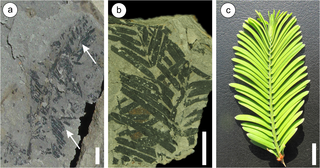The impact of high CO2 concentration on global environmental system can be unraveled by a better understanding of the relationship between the paleo-atmospheric CO2 concentration and ancient climate change. Stomatal parameters (stomatal index) and stomatal density) are reliable proxies to estimate paleo-atmospheric CO2 concentration. Metasequoia has exhibited an evolutionary stasis since its appearance in the Late Cretaceous, and fossilized Metasequoia can be considered to be conspecific with modern Metasequoiabased on the morphology, biochemistry and inferred physiology. Therefore, the paleo-atmospheric CO2 concentration changes over a long geological time can be determined from a correlation between the stomatal index of Metasequoia needles and the paleo-atmospheric CO2 concentration. Prof. ZHOU Zhekun and his team of Xishuangbanna Tropical Botanical Garden (XTBG) used Metasequoia needles from seven localities in China and Japan to reconstruct continuous terrestrial paleo-atmospheric CO2 concentration changes from the middle Miocene to Pleistocene. Based on the reconstructed paleo-atmospheric CO2 concentration curve, they discussed the interaction between paleo-atmospheric CO2 concentration evolution and global environment change since the middle Miocene. The results indicated that: (1) From middle to late Miocene the atmospheric CO2 level stabilized around 350 ppmv which is slightly lower than today. (2) The CO2 level during the Pliocene to Pleistocene was similar to the pre-industrial level and no fluctuation can be detected by this research. (3) The Pleistocene CO2 level estimated by different proxies agreed well with each other. (4) From middle Miocene to Pleistocene, when the global temperature decreased sharply, the global CO2 level decreased by more than 50 ppmv, which may suggest that CO2 decrease and temperature decrease are coupled. The study entitled “Evolutionary History of Atmospheric CO2 during the Late Cenozoic from Fossilized Metasequoia Needles” has been published in PLoS ONE. 
Fossilized Metasequoia branchlet and needles from Tokamachi (a) and Kumagaya (b) as examples to show the megafossils of Metasequoia used in this research, compare with a modern Metasequoia branchlet (c). White arrows in (a) indicate the branchlet. |

